Turning early AI adoption into strategic long-term success means forging the path ahead.
Most companies are still navigating the early stages of AI adoption. Pilots have been launched, productivity gains evaluated, and technological investments made.
But this is only the beginning. Slalom’s 2024 survey of 200 C-suite executives finds that many organizations are now at a critical crossroads: while AI investment is rising and innovation is accelerating, too many leaders risk falling into the trap of complacency, satisfied with early wins rather than pursuing the transformative potential AI offers. The real challenge isn’t just adopting AI as a differentiator—companies must ensure their AI strategies are actionable at every level of the business, turning bold visions into sustainable, transformative outcomes.
The time for incremental change is over. Now is the moment to fundamentally reimagine roles, revolutionize processes, and cultivate the human skills that will unlock AI’s true potential. Yes, this transformation will be complex and sometimes messy—but that’s the price of pioneering. Embrace the challenge, navigate with agility, and turn obstacles into opportunities. The first steps in AI have been taken, but the journey is far from over. Will you choose to follow, or will you forge the path that shapes the future?
Get a free executive summary
Most companies are still in the early stages of AI adoption
If you feel like you’re just beginning to find your AI stride, you’re not alone. Despite the media hype and rapid advancement of generative AI (GenAI) over the last two years, many companies are still in the early stages of AI adoption—exploring pilot projects and focusing on boosting productivity. In fact, 79% of organizations are running pilot AI initiatives, and 68% have already seen productivity gains.
Where is your organization in its AI transformation journey?
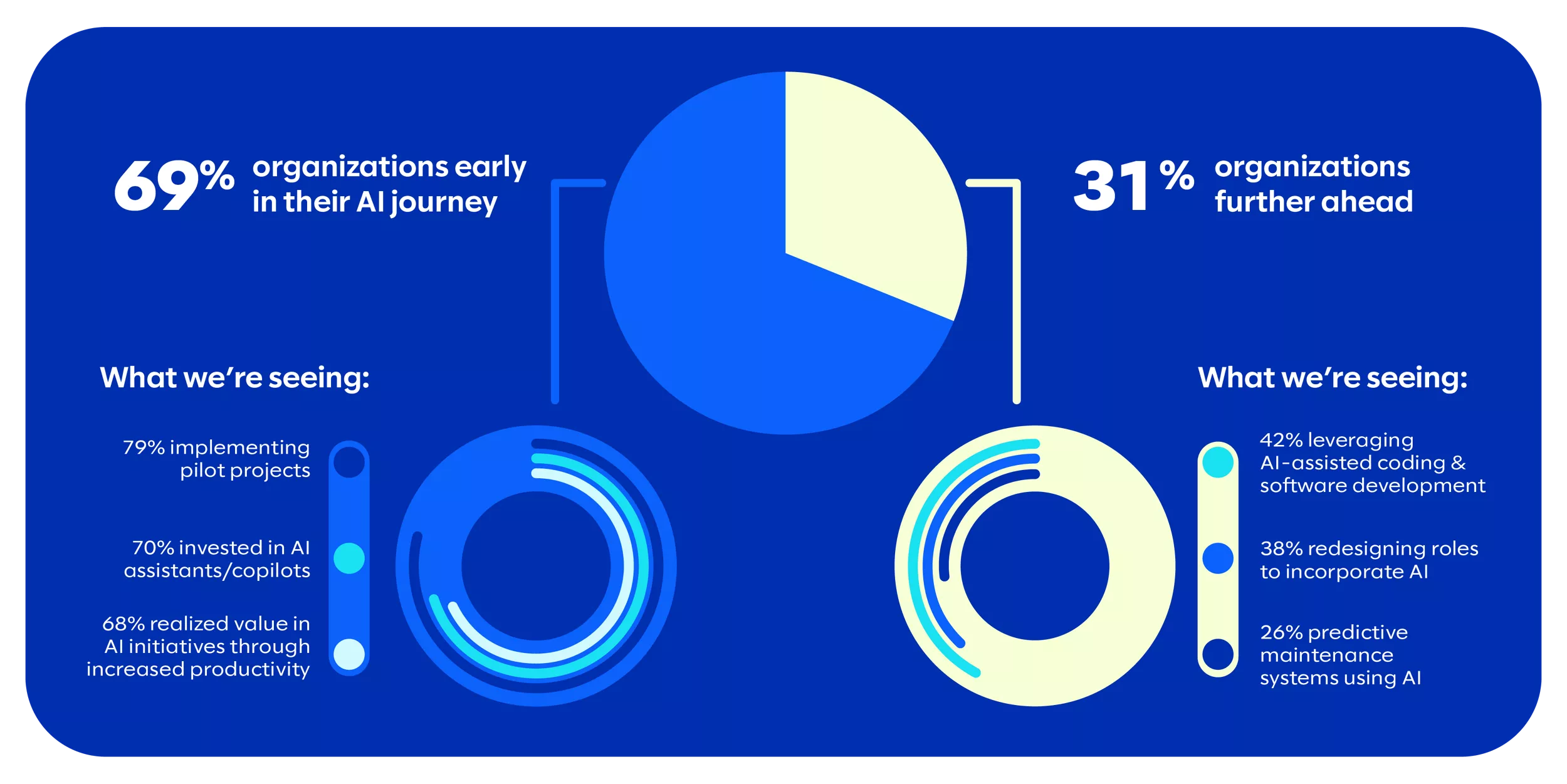 While 69% of organizations remain in the early stages of AI adoption, focused on pilot projects and productivity gains, only 31% are beginning to capitalize on AI’s potential for differentiation and disruption through more advanced applications.
While 69% of organizations remain in the early stages of AI adoption, focused on pilot projects and productivity gains, only 31% are beginning to capitalize on AI’s potential for differentiation and disruption through more advanced applications.
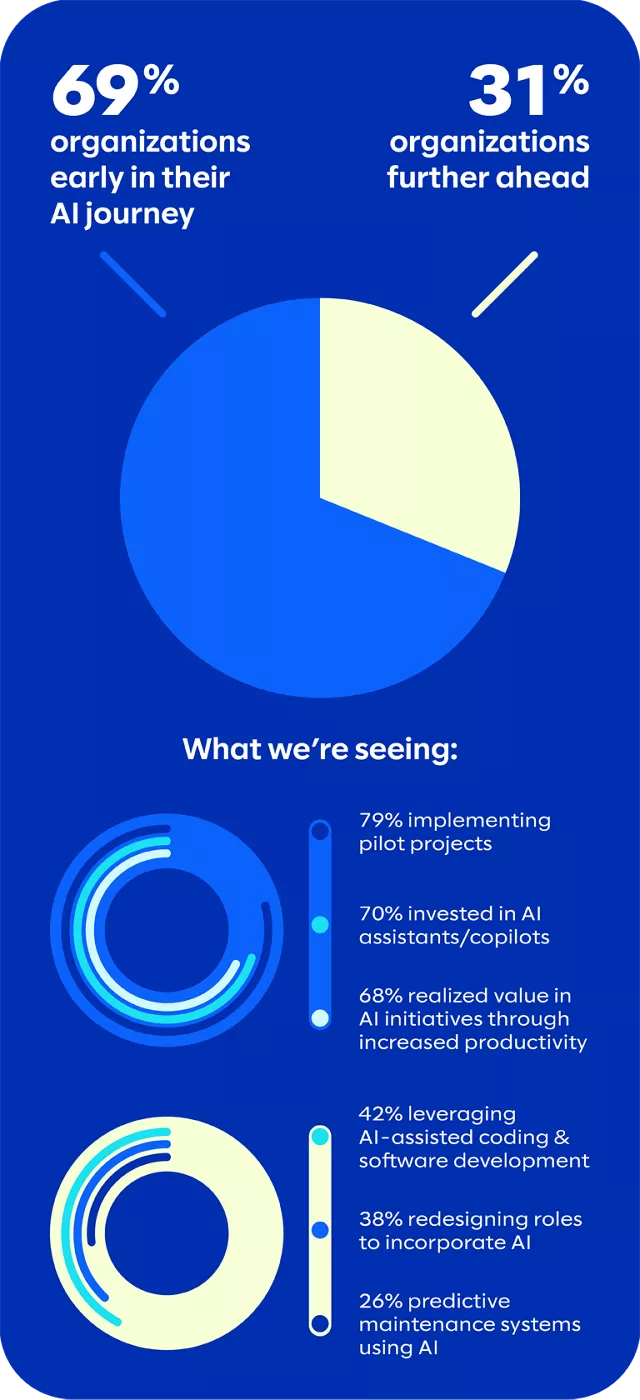 While 69% of organizations remain in the early stages of AI adoption, focused on pilot projects and productivity gains, only 31% are beginning to capitalize on AI’s potential for differentiation and disruption through more advanced applications.
While 69% of organizations remain in the early stages of AI adoption, focused on pilot projects and productivity gains, only 31% are beginning to capitalize on AI’s potential for differentiation and disruption through more advanced applications.
These numbers demonstrate the momentum of early AI adoption, bringing organizations to a crucial juncture. Now, leaders face a defining decision: continue along the established path of incremental productivity gains or blaze a new trail of AI innovation. For example, while 70% of companies have adopted AI assistants, only 26%-28% are employing them for more advanced use cases in predictive maintenance, manufacturing or logistics process automation, or personalized marketing/product recommendations. Leaders who fail to think strategically about AI as a differentiator may soon find themselves outpaced by those who do.
“Last year, many of our clients focused on achieving productivity gains through AI technology,” explains Ali Minnick, general manager of business advisory services and solution innovation at Slalom. “While individual users have become better and faster at specific tasks, many organizations haven’t yet taken the next step to ask: What do we do with this newfound time and productivity? The most progressive clients we work with are now starting to rethink the future of work—not just in terms of jobs and roles, but around discrete skills and tasks. They’re asking: Where are humans best suited to contribute, and where do we need complementary technology to truly excel?”
The opportunity is clear: Companies that make AI a core part of their strategy and fully embrace its potential will shape the future, unlocking greater innovation and leaving competitors scrambling to keep up.
This is your moment to lead through differentiation.
The AI revolution is unfolding faster than any previous technological shift, making this a time for bold action, not complacency. Though the terrain ahead may look daunting, pressing forward is essential. The true value of AI lies not just in improving productivity but in how it’s uniquely applied to drive lasting, transformative change.
Overall investment in AI is increasing, despite uncertainty
AI generates as many questions as it answers. Will it create jobs or displace them? Spark creativity or stifle it? Drive profits or become a financial drain?
Amid the uncertainty and skepticism, our research finds that 82% of executives plan to increase their AI investments in 2025—up from 70% in 2023. This growing commitment demonstrates AI’s perceived value, but it also raises another important question: Are leaders allocating resources where they will have the most significant impact?
Comparison of 2024 and 2025 AI investment plans among executives
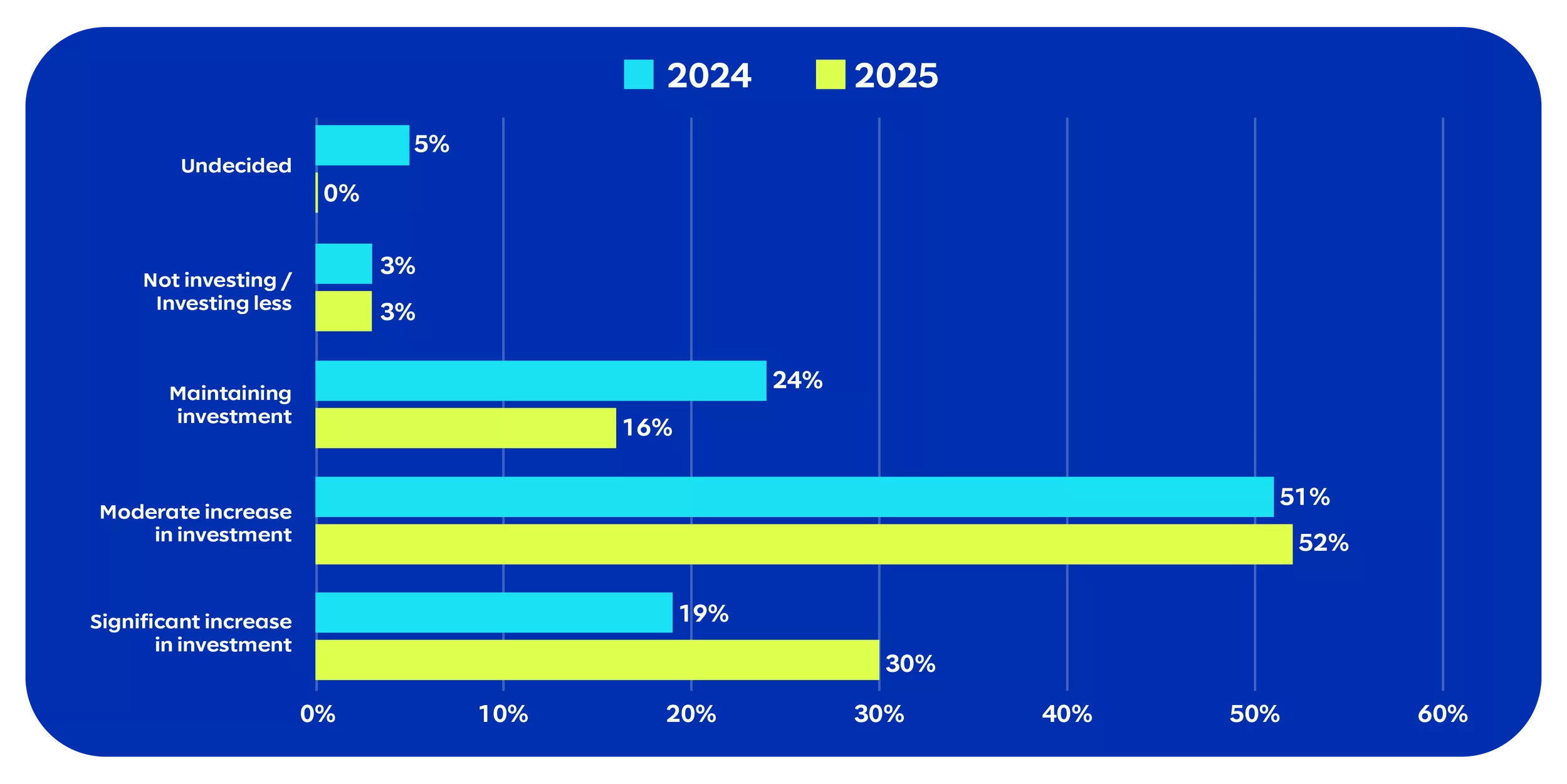 AI investments are set to rise in 2025, with 82% of organizations planning moderate or significant increases, up from 70% in 2024, signaling growing confidence in AI’s long-term value.
AI investments are set to rise in 2025, with 82% of organizations planning moderate or significant increases, up from 70% in 2024, signaling growing confidence in AI’s long-term value.
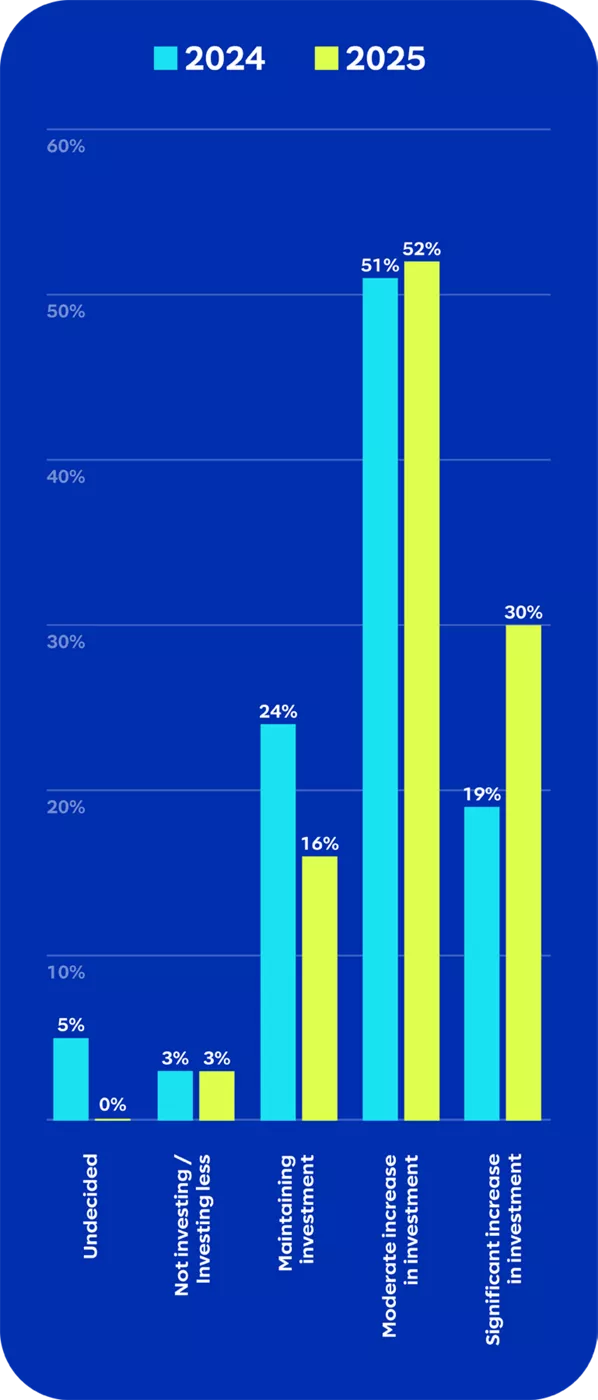 AI investments are set to rise in 2025, with 82% of organizations planning moderate or significant increases, up from 70% in 2024, signaling growing confidence in AI’s long-term value.
AI investments are set to rise in 2025, with 82% of organizations planning moderate or significant increases, up from 70% in 2024, signaling growing confidence in AI’s long-term value.
Delivering scalable, effective AI solutions requires more than just investment—it demands a focused approach that aligns vision with execution. While 94% of leaders predict a positive impact from AI and 86% of executives report tangible benefits—primarily through increased productivity (68%) and reduced operational costs (50%)—most AI initiatives remain in the pilot phase. This reveals a critical disconnect between financial commitment and strategic execution. Despite pouring resources into AI, many companies still struggle to move beyond experimentation.
“There’s a sense of urgency that wasn’t as prominent at the start of GenAI adoption, but it’s now growing, causing both concern and excitement,” says Tamarah Usher, senior director of AI strategy and insights at Slalom. “This urgency is a powerful motivator, driving people to experiment with different approaches and make AI work for them. It’s a significant shift. You might expect the urgency to decrease over time, but it hasn’t—because we continue to see advancements and opportunities, and everyone is catching on and ready to move forward.”
And we’re seeing progress: Half of companies are redesigning their business processes for AI integration, and 70% of those have already experienced accelerated innovation cycles as a result—an incredible opportunity for industry disruption. However, the lack of formal decision-making frameworks is holding many back, as only 29% are using structured processes to prioritize their AI efforts.
How can companies expect to capitalize on AI’s potential if they lack the mechanisms to direct their investments effectively? A strategic approach is essential. Organizations that continue to invest without clear direction may find themselves struggling to match AI’s rapid evolution.
There’s a gap between strategy and execution
While AI holds immense potential, the gap between vision and reality continues to grow. In 2023, nearly a third (28%) of leaders said the pace of AI advancement matched their pace of innovation. By 2024, that number has dropped to just 15%, underscoring the mounting challenge of keeping up with AI’s rapid evolution.
“Organizations, regardless of size, feel they are falling behind in adopting AI, experiencing a sense of FOMO (fear of missing out),” says Kevin McClelland, general manager and executive lead of Slalom AI. “However, with the right guidance, the mindset quickly shifts from fear to empowerment. Companies start feeling confident that they can get ahead of the curve, excite stakeholders, and create growth opportunities for employees.”
The message is clear: AI success won’t come from tinkering or relying on past ways of working. Companies need adaptive, forward-looking strategies that align technological innovation with core business objectives, ensuring investment and execution move in lockstep.
The challenge for companies is not just in adopting AI but in transforming early productivity gains into sustainable competitive advantages. For instance, while 55% of companies are investing in large language models (LLMs) and chatbots, far fewer are investing in transformative technologies such as AI-enhanced process automation in areas such as manufacturing and logistics (27%), predictive maintenance systems (26%), or AI-powered decision support systems (33%). Leaders need to ask themselves: Are we using AI to simply work faster, or are we positioning ourselves to innovate and disrupt?
Where does the responsibility for driving your AI transformation reside in your company today?
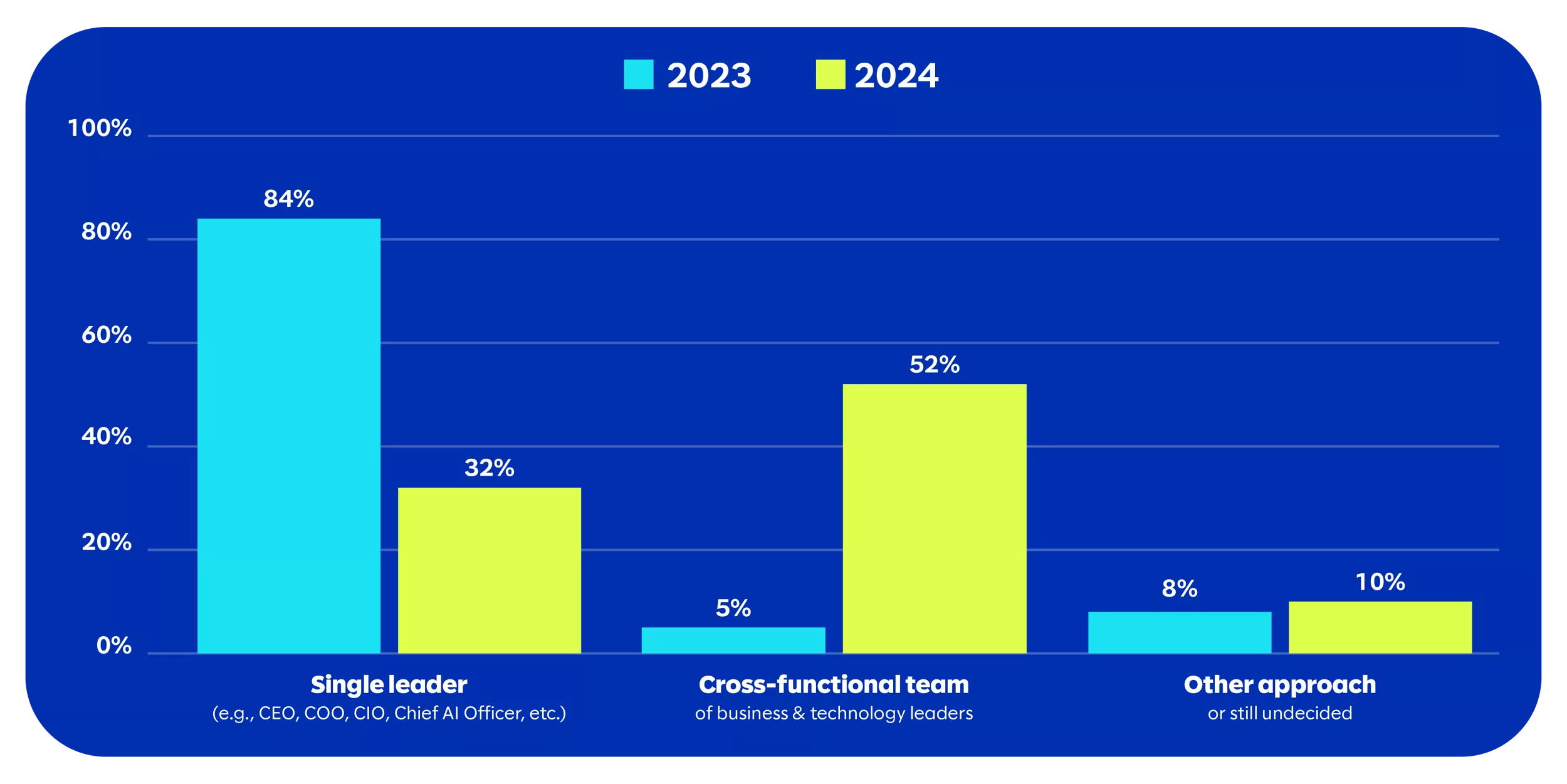 In 2024, AI ownership is shifting from single leaders (32%) to cross-functional teams (52%), emphasizing the growing need for collaborative leadership to drive scalable AI initiatives.
In 2024, AI ownership is shifting from single leaders (32%) to cross-functional teams (52%), emphasizing the growing need for collaborative leadership to drive scalable AI initiatives.
 In 2024, AI ownership is shifting from single leaders (32%) to cross-functional teams (52%), emphasizing the growing need for collaborative leadership to drive scalable AI initiatives.
In 2024, AI ownership is shifting from single leaders (32%) to cross-functional teams (52%), emphasizing the growing need for collaborative leadership to drive scalable AI initiatives.
The redistribution of AI transformation ownership highlights that leaders are in the midst of rethinking how to integrate AI into their operations. In 2023, we found that over 80% of AI transformation efforts were owned by a single leader—typically the CIO or CEO. By 2024, this responsibility has shifted, with only 32% of organizations placing AI transformation under a single leader (25% with the CIO) and 52% adopting a cross-functional team approach, where both business and technology leaders share equal responsibility. This shift signals progress toward more integrated and collaborative AI leadership, but also introduces complexity and growing pains as businesses transition from siloed ownership to broader collaboration.
To that end, lack of alignment remains one of the most significant barriers to AI productivity. Strategy misalignment is cited as a major obstacle by 33% of respondents, a figure that rises to 41% for companies operating cross-functional teams. While 68% of executives have seen productivity increases, real differentiation will come from turning AI-enabled productivity into creative outcomes that set businesses apart.
The process of integrating AI across teams and departments is messy. AI is not a one-off solution—it’s an ongoing journey that requires companies to reimagine how they operate. Transformation requires a delicate balance of aligning diverse perspectives, unifying business and technology goals, and managing the friction that inevitably arises when roles and responsibilities shift. This underscores the need for an AI Office—a centralized function that enables seamless AI integration across the enterprise, bringing together cutting-edge technology and visionary experts in strategy and innovation.
“The responsibility for how AI is implemented and who makes key decisions should rest with a cross-functional team, owned and driven by the C-suite and leadership. This ensures alignment with their strategic vision for the company,” says Amalia Goodwin, managing director of Business Advisory Services at Slalom. “However, our research found that as more people come to the table, there’s often more misalignment around AI strategy. This highlights the need for organizations to align on where they want their business to go and quickly adapt their strategy to the pace of technological and market changes.”
The path to an effective AI Office can be challenging, reflecting the complex reality of innovation. To succeed, leaders must be fully invested—contributing time, resources, and ideas—while being held accountable for outcomes. It’s not about avoiding conflict or seeking consensus; rather, embracing healthy conflict—even when uncomfortable—is vital to success. Leaders need to bring diverse perspectives together that are aligned to the organization strategy to challenge and refine ideas, a critical process for driving innovation and ensuring impactful AI initiatives.
Organizations need to prioritize the right training and change investments
While AI is often seen as a technical revolution, its success fundamentally depends on people. Leaders consistently point to human-centric skills—critical thinking, creativity, and collaboration—as the key to future success. Yet, despite this understanding, many companies are still underinvesting in the human side of AI.
Unlocking AI potential with innovative change approaches
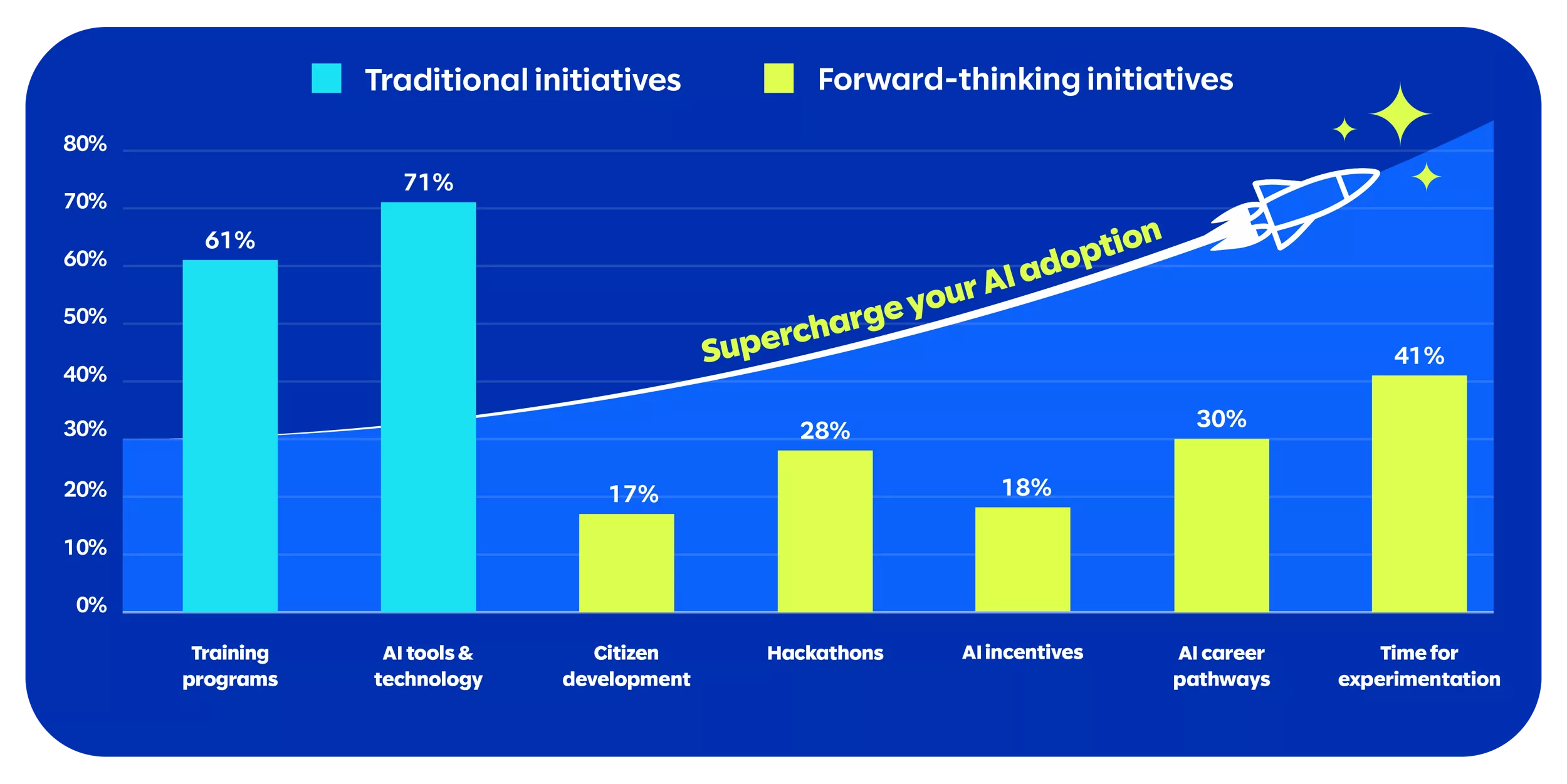 While most organizations remain tied to traditional change management methods—61% offering AI training and 71% providing tools—only a small percentage are embracing more forward-thinking approaches, like hackathons (28%), citizen development programs (17%), or pathways for AI career growth (30%). To keep pace with AI’s rapid evolution, companies must shift toward innovative initiatives that will propel them into the future.
While most organizations remain tied to traditional change management methods—61% offering AI training and 71% providing tools—only a small percentage are embracing more forward-thinking approaches, like hackathons (28%), citizen development programs (17%), or pathways for AI career growth (30%). To keep pace with AI’s rapid evolution, companies must shift toward innovative initiatives that will propel them into the future.
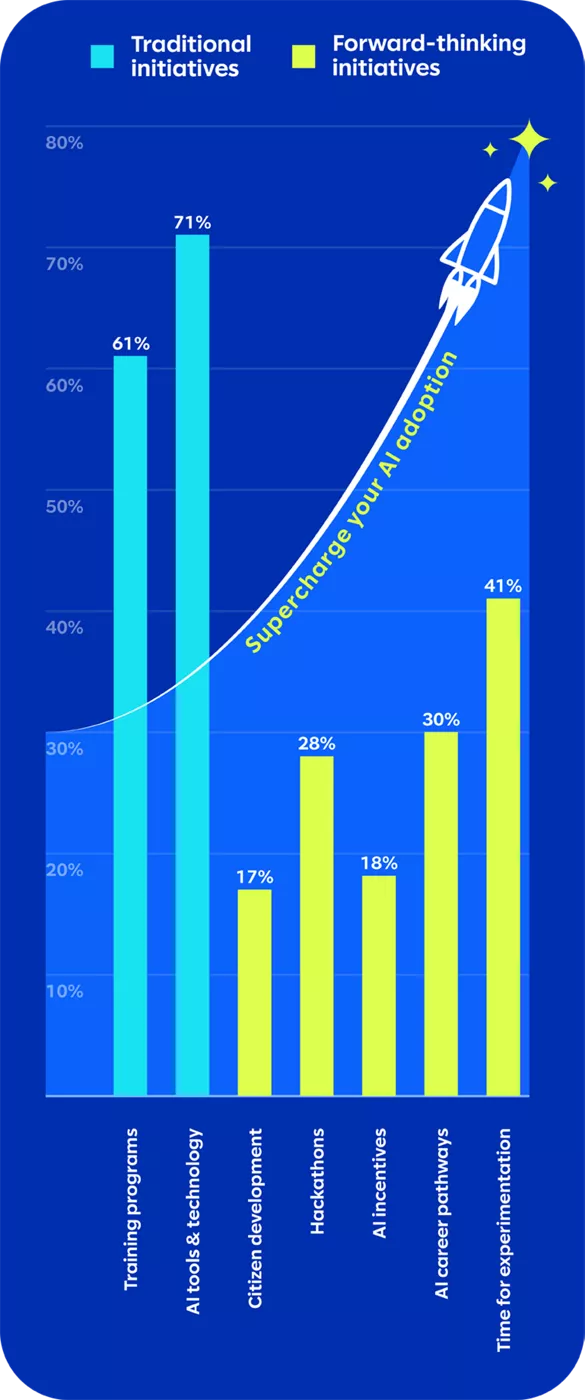 While most organizations remain tied to traditional change management methods—61% offering AI training and 71% providing tools—only a small percentage are embracing more forward-thinking approaches, like hackathons (28%), citizen development programs (17%), or pathways for AI career growth (30%). To keep pace with AI’s rapid evolution, companies must shift toward innovative initiatives that will propel them into the future.
While most organizations remain tied to traditional change management methods—61% offering AI training and 71% providing tools—only a small percentage are embracing more forward-thinking approaches, like hackathons (28%), citizen development programs (17%), or pathways for AI career growth (30%). To keep pace with AI’s rapid evolution, companies must shift toward innovative initiatives that will propel them into the future.
Our data reveals a significant gap in workforce support. While 71% of companies are providing tools to leverage AI and 61% are offering training programs, only 39% are offering the coaching and mentoring necessary to truly integrate AI into daily workflows. This points to a crucial disconnect between providing technology and equipping people to use it effectively.
Workforce challenges are also evident, with 37% of leaders citing resistance to change and 42% identifying a lack of skills and training as major barriers to AI adoption.
“There’s a misconception that we can ‘one and done’ train or ‘boot camp’ our way to success,” Minnick says. “This is a much different transformation of human talent and skill.” To overcome these challenges, organizations need to move beyond traditional, rigid development approaches and instead cultivate an environment where continuous learning and skill development are encouraged and prioritized.
Currently, 57% of organizations are redesigning roles to capture the productivity benefits of AI by automating repetitive tasks and allowing employees to focus on more strategic contributions. However, only 17% of companies are introducing programs that ensure work-life balance and support mental health and well-being—vital elements of a sustainable, human-centered AI adoption. Bridging this gap requires leaders to support and encourage their workforce to actively participate in AI innovation.
This is where citizen developers come in. With AI becoming more accessible, nontechnical employees are now using AI to tackle tech-heavy tasks. While 67% of companies have yet to implement citizen development initiatives, there are signs of progress as more businesses begin to decentralize AI responsibility.
To fully harness AI’s power, companies must focus not only on the technology itself but on empowering their people to work alongside it, fostering a culture of continuous learning and adaptability.
“AI, and what it brings to us in this new technology, means that we are constantly becoming that novice, and that is an uncomfortable feeling,” says Goodwin. “But creating systems and processes in which your teams can learn together really helps overcome those barriers.”
Human skills remain critical
As AI becomes more embedded in organizations, the role of human-centric skills is even more critical. In 2023, technical skills like software development were considered most essential for the future. However, in 2024, those have been overtaken by skills such as critical thinking and problem-solving, and collaboration and teamwork.
Top-ranked skills for the AI-driven workplace
As Emad Mostaque, founder and former CEO of Stability AI, puts it, “The cost of intelligence is plummeting. The value of human ingenuity in applying this new resource will skyrocket—it will shortly become one of the most important skills you can have.”
This shift reflects the evolving nature of AI, from a technical tool to a collaborative enabler that enhances human capabilities.
“People’s self-identity, which has traditionally been tied to the work they do and the roles they hold, is shifting,” Goodwin says. “In the future, skills—including technology skills—will become the ‘currency’ in which people trade.”
As the distinction between businesspeople and technologists continues to blur, the value of skills is evolving beyond traditional expertise. This requires not only interpersonal and collaboration skills but also the ability to adapt and learn continuously. And one of the most critical drivers of this adaptability is curiosity—a trait that fuels the exploration of new ideas, encourages experimentation, and helps people navigate the ever-changing technological landscape.
“Curiosity is a skill we often lose over time, but organizations that foster it are likely to be more successful,” adds Minnick. “Your success will increasingly be linked to whether you cultivate an environment where curiosity and creativity can thrive.”
The future of work, therefore, will not depend solely on individuals with technical expertise. Instead, it will rely on teams who can seamlessly integrate AI into broader organizational goals, using AI as a tool to amplify their creativity and collaboration.
The road ahead
AI is moving at an unprecedented pace, and what we’ve seen so far from pilots and productivity gains is just the beginning. The key to unlocking AI’s full potential lies in aligning strategy with execution—transforming early efforts into strategic, organization-wide initiatives. As AI becomes more deeply embedded into organizations, the potential for innovation and transformation will grow exponentially. Success will depend on seamlessly integrating AI into core business operations, ensuring that technological advancements directly support strategic business objectives.
Organizations must focus not only on the technology but also on fostering a culture of continuous learning and adaptability. By developing the human-centric skills needed for the future, and embracing the complexity of AI adoption, companies will unlock new levels of efficiency and accelerate innovation through AI-enabled experiences.
The road ahead is clear: Companies that act boldly, make AI integral to their operations, and focus on training and innovation will stand out as future industry leaders. Others risk watching the horizon of opportunity recede in their rearview mirror. If you’re ready to lead in the AI era, we can help. Connect with us to take the next step on your journey toward becoming AI-enabled and future-ready.
Methodology
This study surveyed 200 C-suite executives, with 62% in CEO or chief technology leadership roles, and the remaining 38% holding various other senior executive positions. Participating companies reported annual revenues ranging from $500 million to $10 billion, with nearly half (48%) falling between $1 billion and $5 billion. The sample included a cross-industry representation, with major sectors including healthcare, technology, manufacturing, retail and consumer goods, and financial services. The survey was conducted between September 10 and September 18, 2024.






